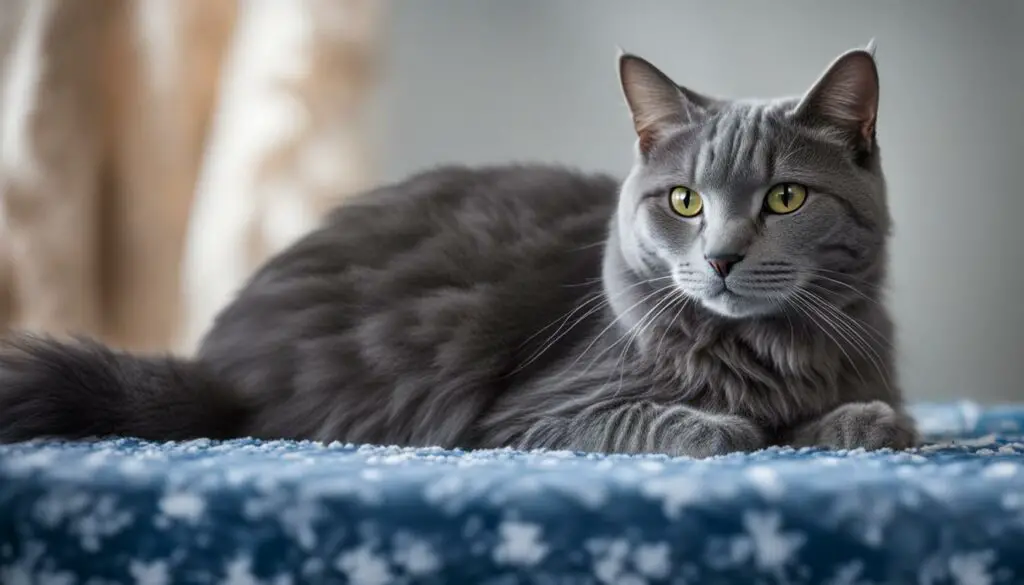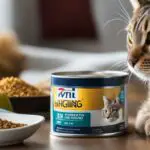Cat dandruff is a common condition in cats, characterized by dry, flaky skin. It can be caused by various factors such as a lack of fatty acids in their diet, dehydration, grooming issues, or underlying health conditions. Luckily, there are several effective solutions and treatments for cat dandruff that can help alleviate the symptoms and keep your feline friend’s skin healthy.
In this article, I will discuss how to identify if your cat has dandruff, the possible causes of cat dandruff, diagnosing the condition, and various treatment options. I will also provide tips on nutrition, hydration, grooming, and environmental factors that can contribute to managing cat dandruff. Finally, I will touch on when it’s necessary to seek veterinary care and some home remedies that can be used in conjunction with traditional treatments.
Key Takeaways:
- Cat dandruff is a common condition caused by various factors.
- Identifying symptoms and properly diagnosing cat dandruff is important for effective treatment.
- Treating cat dandruff involves addressing the underlying cause and implementing a comprehensive plan.
- Nutrition, hydration, grooming, and environmental factors play a role in managing cat dandruff.
- If dandruff persists or is accompanied by concerning symptoms, it’s important to seek veterinary care.
How Can I Tell If My Cat Has Dandruff?
Cat dandruff is a common condition that many cat owners may encounter. It is important to be able to identify the signs and symptoms of cat dandruff in order to provide appropriate care and treatment for your furry friend.
One of the most obvious signs of cat dandruff is the presence of small, white flakes on your cat’s fur. These flakes can be easily seen and may also be found on furniture, bedding, or other surfaces where your cat spends time. Additionally, cats with dandruff may exhibit increased scratching as a result of the dry and irritated skin.
Dandruff in cats can vary in severity, with some cats experiencing only mild flaking while others may have more noticeable and persistent dandruff. It is important to monitor your cat’s skin condition and seek veterinary care if the dandruff worsens or is accompanied by other concerning symptoms.
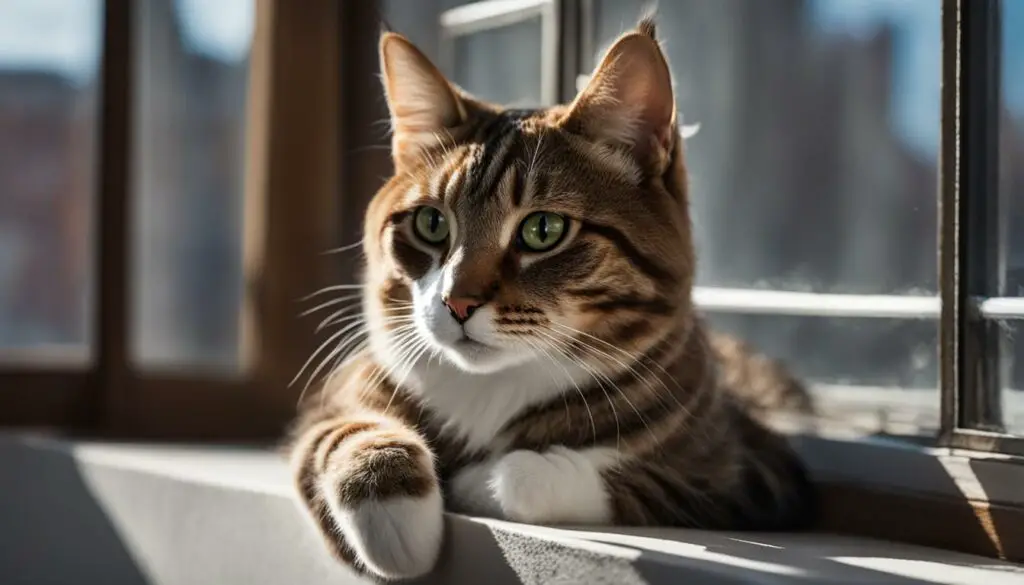
Signs of Cat Dandruff:
- Presence of small, white flakes on the cat’s fur
- Flakes may also be found on furniture and bedding
- Increased scratching and irritation of the skin
- Dry and flaky skin
By being aware of these symptoms, you can take the necessary steps to address and manage cat dandruff, ensuring your cat’s comfort and overall well-being.
Causes of Cat Dandruff
There are several potential causes of cat dandruff. Understanding these causes is crucial in effectively treating and managing the condition. Here are some of the most common reasons for cat dandruff:
- Diet: A lack of essential fatty acids in a cat’s diet can lead to dry and flaky skin, resulting in dandruff. Ensuring that your cat’s diet includes foods rich in omega fatty acids can help improve their skin health.
- Dehydration: Cats need to stay well-hydrated to maintain healthy skin. When they don’t consume enough water, their skin can become dry and flaky, leading to dandruff. Providing fresh water and incorporating wet food into their diet can help increase their hydration levels.
- Grooming issues: Cats that have difficulty grooming themselves properly may develop dandruff. This can be due to obesity, arthritis, or other mobility issues that make it challenging for them to reach certain areas of their bodies. Regular brushing and grooming can help stimulate the production of natural oils and prevent dandruff.
- Underlying health conditions: Dandruff can sometimes be a symptom of an underlying health issue, such as parasites, allergies, or metabolic disorders. Identifying and addressing these conditions is essential in effectively managing cat dandruff.
By identifying the specific cause of your cat’s dandruff, you can take the necessary steps to treat and manage the condition effectively. Consulting with a veterinarian can help pinpoint the underlying cause and determine the best course of action to alleviate your cat’s dandruff.
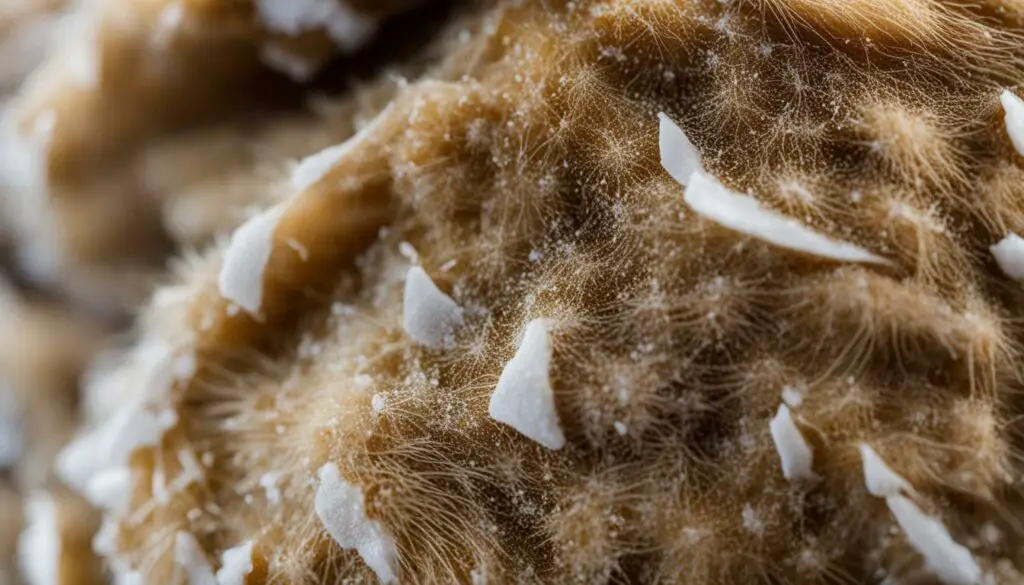
Table: Common Causes of Cat Dandruff
| Cause | Description |
|---|---|
| Diet | A lack of essential fatty acids in the diet can lead to dry and flaky skin. |
| Dehydration | Inadequate hydration can result in dry and flaky skin, leading to dandruff. |
| Grooming issues | Cats that have difficulty grooming themselves may develop dandruff. |
| Underlying health conditions | Dandruff can be a symptom of parasites, allergies, or metabolic disorders. |
Diagnosing Cat Dandruff
Diagnosing cat dandruff is typically done through a visual examination of the cat’s fur and skin. As a pet owner, you may notice small, white flakes on your cat’s fur or on surfaces where they frequently groom themselves. These flakes are a common symptom of dandruff. Additionally, you may observe signs of skin irritation, such as redness or itchiness.
If you suspect that your cat has dandruff, it is recommended to consult with a veterinarian for a proper diagnosis. A veterinarian will examine your cat’s skin and may perform additional tests to rule out any underlying health conditions or allergies that could be causing the dandruff. These tests can help determine the best course of treatment for your furry friend.
Diagnosing Cat Dandruff
During the visual examination, the veterinarian will thoroughly inspect the cat’s skin and fur, paying particular attention to areas where dandruff is most prevalent, such as along the back, tail, and base of the ears. They may also gently part the fur to examine the underlying skin for further signs of dandruff or irritation.
In some cases, the veterinarian may collect skin samples for a closer examination under a microscope. This can help identify any potential infections or parasites that may be contributing to the dandruff. Blood tests may also be conducted to check for any underlying health conditions that could be causing the dandruff.
By diagnosing cat dandruff accurately, veterinarians can develop appropriate treatment plans to address the underlying causes and alleviate the symptoms, resulting in healthier skin and a happier, more comfortable cat.
Treating Cat Dandruff
When it comes to treating cat dandruff, it’s important to address the underlying cause and develop a comprehensive treatment plan. Here are some effective options to help alleviate dandruff and promote a healthy coat for your feline friend.
Dietary Adjustments
One of the key factors in treating cat dandruff is ensuring that your cat is getting enough essential fatty acids in their diet. Omega-3 and omega-6 fatty acids are crucial for maintaining healthy skin and can help reduce dandruff. Consider adding a fish oil supplement or choosing high-quality cat food that is formulated to promote skin health.
Grooming and Hygiene
Regular grooming plays a vital role in managing cat dandruff. Brushing your cat’s fur not only helps remove dead skin cells and distribute natural oils, but it also stimulates blood circulation, promoting a healthier coat. In addition to brushing, you can also use gentle cat-friendly shampoos specifically designed to moisturize the skin and reduce dandruff. Remember to rinse the shampoo thoroughly to avoid any skin irritation.
Managing Underlying Health Conditions
If your cat’s dandruff is caused by an underlying health condition, such as allergies or parasites, it’s crucial to address and manage these conditions. Consult with your veterinarian to determine the best course of action, which may include medications, allergy testing, or regular parasite control treatments.
By combining these treatment options and working closely with your veterinarian, you can effectively manage cat dandruff and improve the overall health of your furry companion.
Table: Cat Dandruff Treatment Options
| Treatment Option | Description |
|---|---|
| Dietary Adjustments | Adding essential fatty acids to the cat’s diet, such as fish oil supplements or specialized cat food formulated for skin health. |
| Grooming and Hygiene | Regular brushing to remove dead skin cells and stimulate oil production, along with the use of cat-friendly shampoos. |
| Managing Underlying Health Conditions | Treating allergies, parasites, or other medical conditions that may contribute to dandruff. |
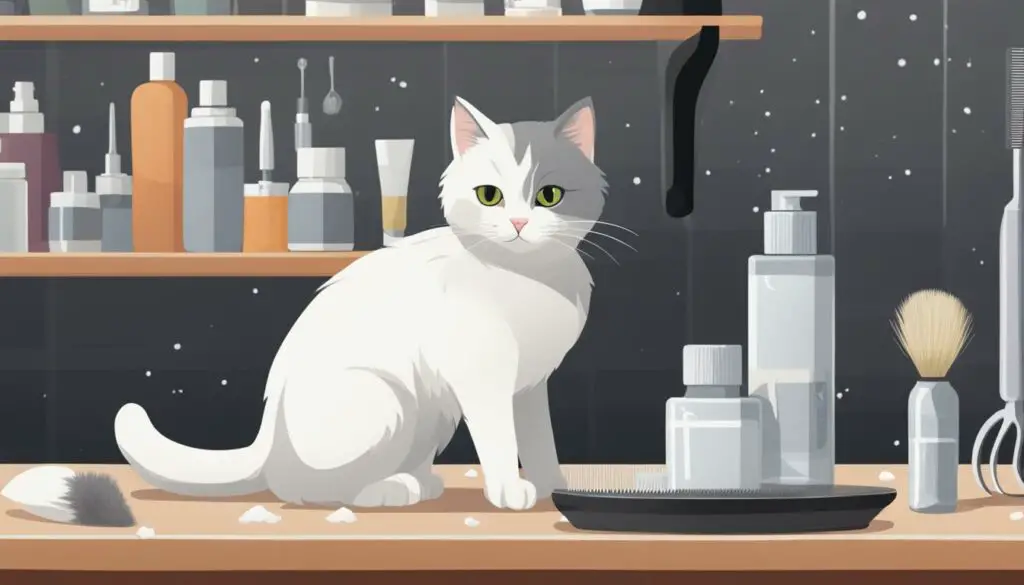
Nutrition and Hydration for Cat Dandruff
Proper nutrition and hydration play a vital role in managing cat dandruff. A balanced diet that includes essential nutrients can improve the condition of your cat’s skin and reduce dandruff. Foods rich in omega fatty acids, such as fish oil, are particularly beneficial for promoting healthy skin. Including these omega-rich foods in your cat’s diet can help moisturize their skin and alleviate dandruff.
Additionally, ensuring adequate hydration is crucial for maintaining healthy skin in cats. Dehydration can contribute to dry and flaky skin, exacerbating dandruff. To keep your cat hydrated, provide them with fresh water at all times. You can also incorporate wet food into their diet, as it contains a higher water content and helps increase hydration levels.
Hydration Tips for Cat Dandruff:
- Always have fresh water available for your cat.
- Consider incorporating wet food into their diet.
- Monitor their water intake to ensure they are drinking enough.
Remember, maintaining proper nutrition and hydration is an ongoing process. It’s important to consult with your veterinarian to determine the best diet and hydration plan for your cat’s specific needs. They can provide personalized recommendations and guide you in selecting the most suitable products to support your cat’s skin health.
| Omega-Rich Foods for Cats | Hydration Tips |
|---|---|
| Fish (salmon, mackerel) | Always have fresh water available |
| Chicken | Incorporate wet food into their diet |
| Flaxseed | Monitor water intake regularly |
| Coconut oil |
By focusing on their nutrition and hydration, you can help improve your cat’s skin health and reduce dandruff. Remember to consistently provide a balanced diet and ample hydration to support their overall well-being. Consult with your veterinarian for further guidance on specific dietary needs and hydration strategies for your feline companion.
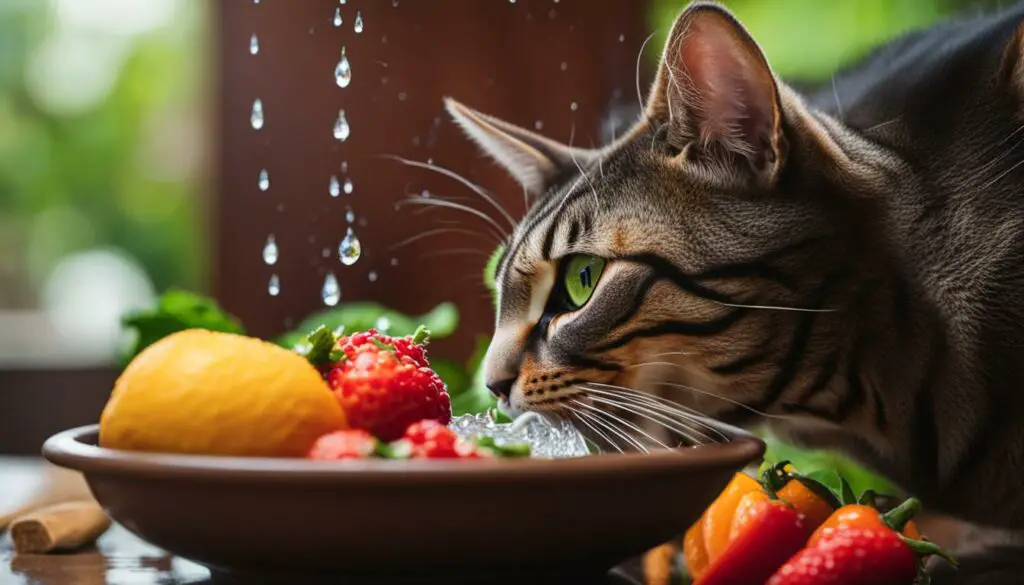
Grooming for Cat Dandruff
Proper grooming is essential for managing cat dandruff and maintaining a healthy coat and skin. Regular brushing helps to remove loose hair, distribute natural oils, and stimulate the production of new, healthier hair. Here are some grooming tips to help alleviate cat dandruff:
1. Brushing:
Regular brushing with a cat-specific brush or comb can help remove dead skin cells and promote healthy skin. Aim to brush your cat at least two to three times a week, focusing on areas prone to dandruff, such as the back, tail, and flanks. Be gentle and use long, smooth strokes to avoid causing any discomfort or skin irritation.
2. Bathing:
While cats generally groom themselves, occasional baths can help remove excess oil and debris from their fur, promoting a healthier coat. Use a mild, cat-friendly shampoo specifically formulated for dandruff or dry skin. Avoid using human shampoos, as they may be too harsh and strip away essential oils.
3. Moisturizing:
Applying a moisturizing cat conditioner or oil after bathing can help hydrate the skin and reduce dandruff. Look for products that contain natural ingredients like aloe vera or oatmeal, which are known for their soothing properties. Follow the manufacturer’s instructions for application, and be sure to rinse thoroughly to avoid any residue that could cause skin irritation.
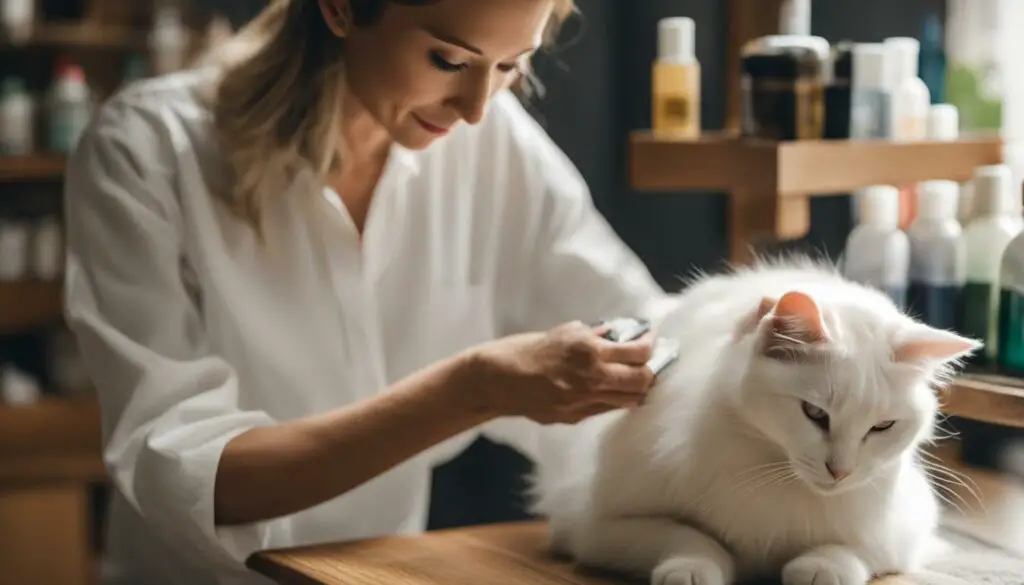
4. Trimming Nails:
Long nails can cause your cat to scratch and irritate their skin, leading to dandruff. Regular nail trimming can help prevent excessive scratching and minimize the risk of skin damage. If you’re unsure how to trim your cat’s nails, consult with a veterinarian or a professional groomer for guidance.
Grooming is not only beneficial for managing cat dandruff but also for strengthening the bond between you and your feline companion. Be patient, use positive reinforcement, and make grooming a positive experience for both you and your cat.
Specialized Shampoos for Cat Dandruff
When it comes to treating cat dandruff, using specialized shampoos can be highly beneficial. These shampoos are specifically formulated to moisturize and condition your cat’s skin, reducing itching and flaking. However, it’s important to note that human shampoos should never be used on cats as they can further irritate the skin and worsen the dandruff. Let’s explore some of the best shampoos for cat dandruff:
| Shampoo | Description |
|---|---|
| Brand A Dandruff Control Shampoo | This shampoo contains gentle cleansing agents and ingredients like oatmeal and aloe vera, which help soothe dry, itchy skin. It effectively removes dandruff flakes while nourishing the skin. |
| Brand B Moisturizing Shampoo | Designed for cats with dry skin, this moisturizing shampoo hydrates and conditions the skin, promoting a healthy coat and reducing dandruff. It contains natural ingredients like coconut oil and chamomile extract. |
| Brand C Anti-Dandruff Shampoo | This shampoo is specifically formulated to target dandruff and restore the skin’s natural balance. It contains ingredients like salicylic acid, which helps exfoliate the skin and reduce flaking. |
When using specialized shampoos, it’s essential to follow the instructions provided by the manufacturer. Make sure to thoroughly rinse the shampoo off your cat’s fur to prevent any residue. Additionally, if your cat has any underlying health conditions, it’s always a good idea to consult with your veterinarian before using any new products.
Remember, while specialized shampoos can help alleviate cat dandruff, it’s important to address the underlying causes as well. A comprehensive treatment approach, including proper nutrition, hydration, grooming, and veterinary care, will provide the best results in managing your cat’s dandruff and maintaining their overall skin health.
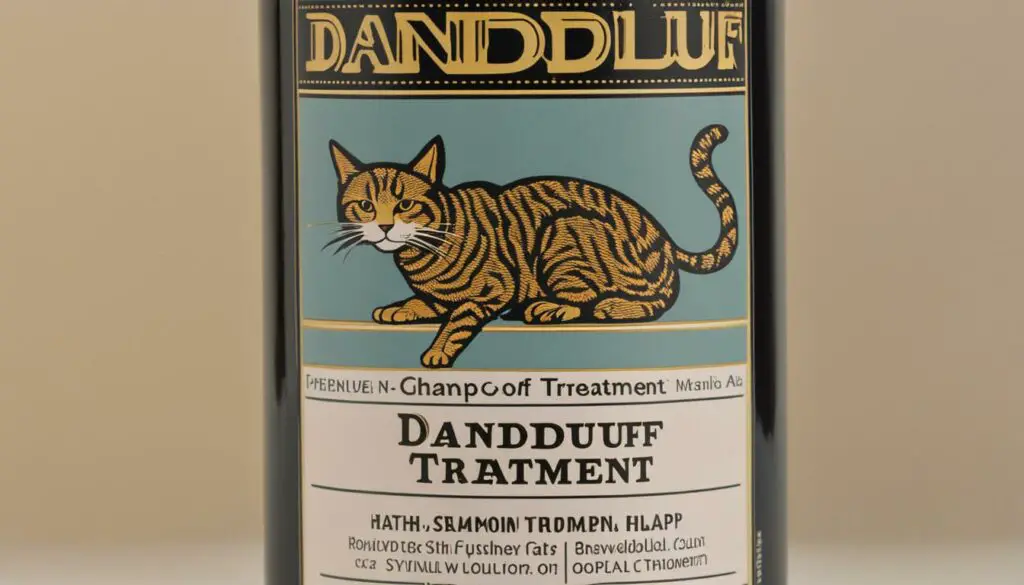
Managing Weight and Hydration for Cat Dandruff
When it comes to managing cat dandruff, maintaining a healthy weight is essential for overall skin health. Obesity can contribute to grooming difficulties, leading to dry and flaky skin. As a responsible cat owner, I prioritize proper weight management for my feline friend to ensure their skin stays healthy and dandruff-free.
In order to help my cat achieve and maintain a healthy weight, I make sure to provide regular exercise opportunities. Engaging in play sessions with interactive toys or using puzzle feeders can help keep my cat active and burn off excess calories. Additionally, I carefully monitor their food intake and provide a balanced diet that meets their nutritional needs without overfeeding.
Hydration is another crucial aspect of managing cat dandruff. Ensuring that my cat has access to fresh water at all times is important for their overall health and skin condition. Additionally, I incorporate wet food into their diet to increase their moisture intake. Wet food not only helps with hydration but also provides additional nutrients that promote healthy skin.
| Weight Management Tips for Cats | Hydration Tips for Cats |
|---|---|
|
|
By focusing on weight management and hydration, I am taking proactive steps to prevent and manage cat dandruff. These simple measures can make a significant difference in maintaining healthy skin for my beloved feline companion.
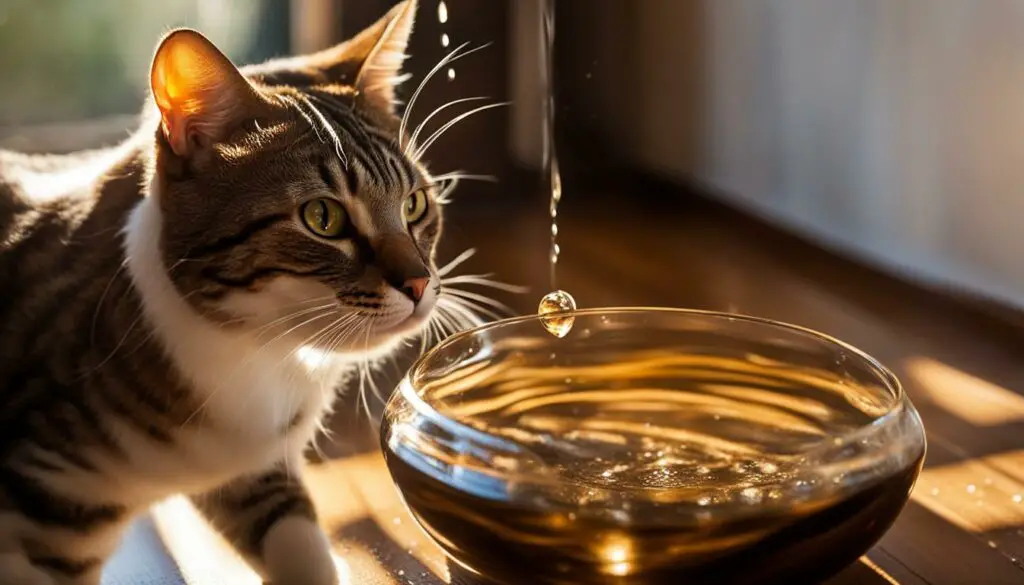
Environmental Factors for Cat Dandruff
When it comes to cat dandruff, environmental factors can play a significant role in exacerbating the condition. Dry air and low humidity, for example, can cause your cat’s skin to become dry and flaky, leading to dandruff. To alleviate this issue, consider incorporating a humidifier into your home. This can help add moisture to the air and prevent your cat’s skin from drying out. By maintaining a healthy level of humidity, you can significantly reduce the occurrence of dandruff and promote healthier skin for your feline friend.
In addition to dry air, exposure to harsh chemicals can also contribute to cat dandruff. When cleaning your home, it’s vital to use cat-friendly cleaners and detergents. These alternatives are less likely to irritate your cat’s skin and can help prevent dandruff. Take the time to read product labels and choose options that are labeled safe for use around pets. By minimizing your cat’s exposure to irritating chemicals, you can create a more comfortable environment and reduce the likelihood of dandruff.
It’s important to note that while environmental factors can contribute to cat dandruff, they are not the sole cause. It’s crucial to address any underlying health issues and implement a comprehensive treatment plan as discussed in previous sections. By taking a holistic approach that considers both environmental factors and medical intervention, you can effectively manage and reduce cat dandruff, ensuring your furry companion enjoys healthy skin and a comfortable life.
Table: Comparative Analysis of Environmental Factors for Cat Dandruff
| Environmental Factor | Impact on Cat Dandruff |
|---|---|
| Dry Air and Low Humidity | Increases the likelihood of dry, flaky skin and dandruff. |
| Exposure to Harsh Chemicals | Can irritate the skin and contribute to dandruff. |
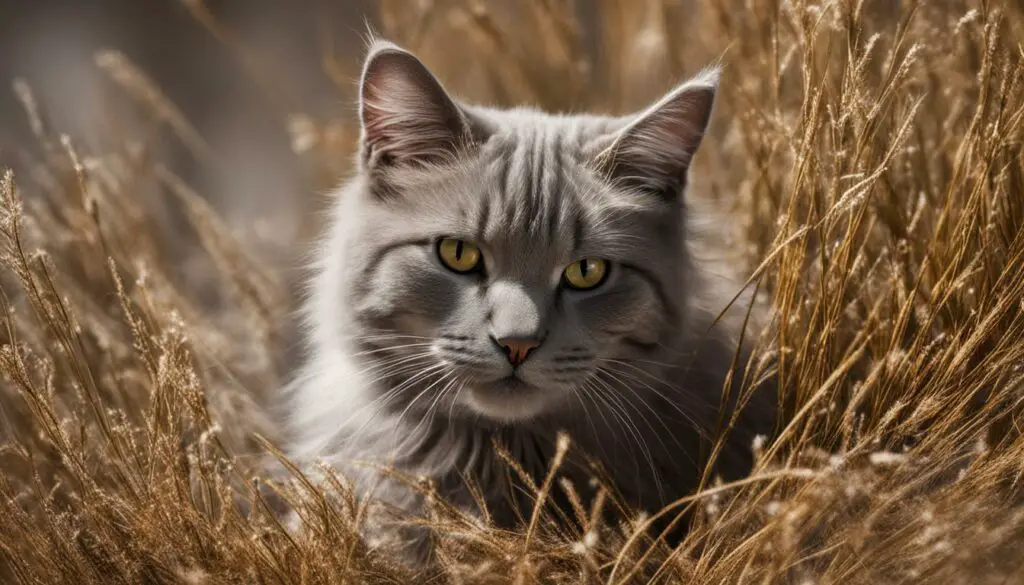
“Maintaining a healthy level of humidity and minimizing exposure to harsh chemicals can significantly reduce the occurrence of cat dandruff and promote healthier skin.” – Dr. Emily Thompson, Veterinarian
When to Seek Veterinary Care for Cat Dandruff
If your cat is experiencing dandruff, it is important to know when it’s time to seek veterinary care. While cat dandruff is often a benign condition, it can sometimes be a sign of an underlying health issue that requires professional treatment. Here are some signs that indicate it’s time to consult with a veterinarian:
- If your cat’s dandruff persists or worsens despite implementing proper care and treatment.
- If your cat shows signs of discomfort or excessive scratching.
- If you notice any skin inflammation, redness, or sores on your cat’s skin.
- If your cat’s dandruff is accompanied by hair loss or changes in coat appearance.
- If your cat has other concerning symptoms such as lethargy, weight loss, or changes in appetite.
By seeking veterinary care, you can ensure that your cat receives a thorough examination to identify any underlying causes of the dandruff. A veterinarian can perform diagnostic tests, such as skin scrapings or allergy tests, to determine the root cause and recommend appropriate treatment options. They can also provide guidance on proper grooming techniques, diet adjustments, and any necessary medications or supplements.
Remember, early detection and treatment of any underlying health conditions can help prevent the dandruff from progressing and ensure your cat’s overall well-being. If you’re unsure whether your cat’s dandruff warrants a visit to the vet, it’s always better to err on the side of caution and consult with a professional.
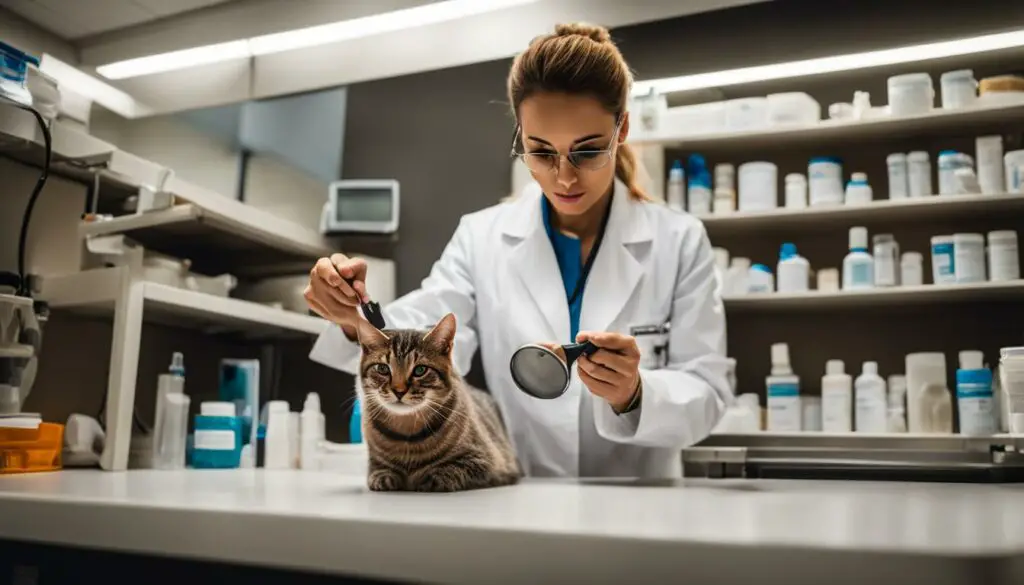
Home Remedies for Cat Dandruff
While there are effective treatments available for cat dandruff, some pet owners prefer to explore natural remedies to alleviate their feline’s symptoms. When considering home remedies, it’s important to consult with a veterinarian to ensure they are safe and appropriate for your cat. Here are a few natural remedies that may help manage cat dandruff:
1. Olive Oil
One home remedy for cat dandruff is to add a small amount of olive oil to your cat’s food. Olive oil is rich in fatty acids, which can help moisturize the skin and reduce flakiness. Start with a few drops and gradually increase the amount as recommended by your veterinarian.
2. CBD Shampoo
CBD-infused shampoos can be soothing for cats with dandruff and irritated skin. CBD has anti-inflammatory properties that can help reduce skin inflammation and itching. It’s important to use shampoos specifically formulated for cats and consult with your veterinarian before incorporating CBD products into your cat’s grooming routine.
3. Stress Reduction
Stress can contribute to skin issues in cats, including dandruff. Creating a calm and stress-free environment for your cat can help improve their overall skin health. Provide them with a cozy and quiet space, engage in regular play and exercise, and consider using pheromone diffusers or calming sprays to help reduce anxiety.
Keep in mind that while these home remedies may provide temporary relief, they are not a substitute for veterinary care. If your cat’s dandruff persists or is accompanied by other concerning symptoms, it’s important to seek professional advice from a veterinarian.
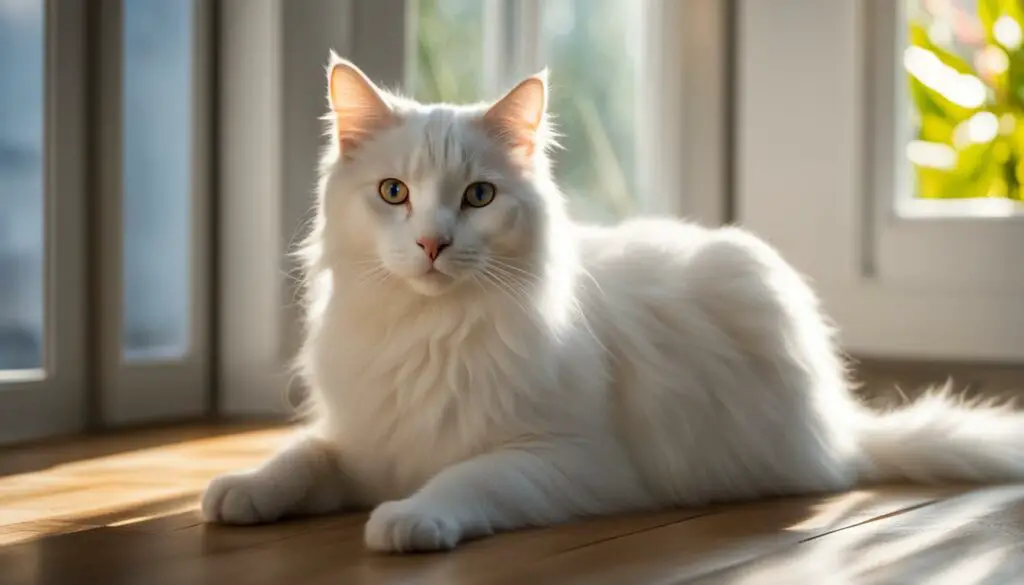
Table: Pros and Cons of Home Remedies for Cat Dandruff
| Home Remedies | Pros | Cons |
|---|---|---|
| Olive Oil | Natural moisturizer for the skin | May cause gastrointestinal upset if ingested in large quantities |
| CBD Shampoo | Anti-inflammatory properties | May require experimentation to find the right CBD product and dosage |
| Stress Reduction | Promotes overall well-being | May not address the root cause of dandruff |
It’s important to monitor your cat’s response to any home remedy and discontinue use if any adverse reactions occur. Regular veterinary check-ups and professional guidance are essential for maintaining your cat’s skin health and overall well-being.
Conclusion
After exploring the various aspects of cat dandruff, it is clear that this common condition can be effectively managed with the right care and treatment. By understanding the causes of cat dandruff, such as a lack of fatty acids in their diet or underlying health conditions, we can take appropriate steps to address these factors. Diagnosing cat dandruff involves recognizing the symptoms and, if necessary, seeking veterinary care for a thorough examination.
Treating cat dandruff requires a comprehensive approach that includes adjusting the cat’s diet, maintaining proper hydration, and regular grooming. Specialized shampoos formulated for cats can provide relief from dandruff and soothe the skin. It’s also important to consider environmental factors and ensure a clean and stress-free living environment for our feline friends.
In addition to traditional treatments, there are some home remedies that can help manage cat dandruff. However, it is crucial to consult with a veterinarian before trying any home remedies to ensure they are safe and suitable for your cat’s specific needs.
By following these guidelines and working closely with a veterinarian, we can keep our cats’ skin healthy and free from dandruff. Remember, if the dandruff persists or is accompanied by other concerning symptoms, it is always best to seek professional veterinary care for proper diagnosis and treatment.
FAQ
How can I tell if my cat has dandruff?
Look for small, white flakes on your cat’s fur and signs of skin irritation. Increased scratching may also be a symptom of cat dandruff.
What are the causes of cat dandruff?
Cat dandruff can be caused by a lack of fatty acids in their diet, dehydration, grooming issues, or underlying health conditions such as allergies or parasites.
How is cat dandruff diagnosed?
Cat dandruff is usually diagnosed through a visual examination of the cat’s fur and skin. Additional tests may be necessary to rule out underlying health conditions or allergies.
How is cat dandruff treated?
Treatment for cat dandruff involves addressing the underlying cause. This can include adjusting the cat’s diet, maintaining proper hydration, regular grooming, using specialized shampoos, and managing underlying health conditions.
What nutrition and hydration tips can help with cat dandruff?
A balanced and nutritious diet, including foods rich in omega fatty acids, can help improve the condition of the cat’s skin. Ensuring proper hydration through fresh water and wet food can also help reduce dandruff.
How can I groom my cat to help with dandruff?
Regular brushing of the cat’s fur can help remove loose hair and stimulate the production of natural oils, improving the condition of the skin and reducing dandruff. Use proper grooming techniques and tools to prevent skin irritation.
Are there specialized shampoos for cat dandruff?
Yes, specialized shampoos designed for cats can help alleviate dandruff and soothe the skin. These shampoos are formulated to moisturize and condition the cat’s skin, reducing itching and flaking.
How can I manage weight and hydration for cat dandruff?
Maintaining a healthy weight is important for overall skin health in cats. Regular exercise and a balanced diet can help manage weight and improve grooming. Adequate hydration through water or wet food is also crucial.
What environmental factors contribute to cat dandruff?
Dry air and low humidity can contribute to cat dandruff. Using a humidifier in the home can help add moisture to the air and prevent the cat’s skin from drying out.
When should I seek veterinary care for cat dandruff?
If the dandruff persists or is accompanied by other concerning symptoms, it is important to seek veterinary care. A veterinarian can help identify any underlying health issues and recommend appropriate treatment options.
Are there any home remedies for cat dandruff?
Some home remedies, such as adding olive oil to the cat’s food or using CBD shampoo, may help manage cat dandruff. However, it’s important to consult with a veterinarian before trying any home remedies to ensure they are safe and appropriate.

